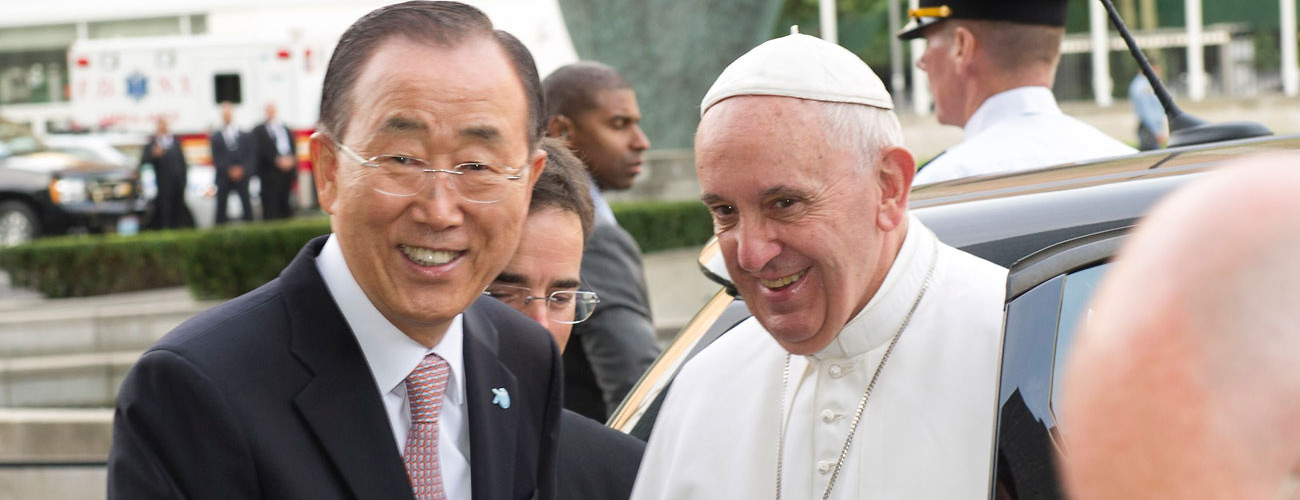Secretary-General Ban Ki-moon welcomes Pope Francis to UN headquarters. New York, September 25, 2015. (UN Photo/Mark Garten)
If you are among those who think that the United Nations is becoming irrelevant, today might look to you rather strange. With the largest summit of heads of states in a decade, including Presidents Obama and Xi Jinping, the United Nations Headquarters in New York is welcoming the representatives of 193 countries to adopt a new universal development agenda, the Sustainable Development Goals, for the next fifteen years. Even the Pope, incidentally a head of state himself, will join the summit, where he is expected to urge the world’s leaders to act on climate, inequality, and poverty.
The new Sustainable Development Goals (SDGs) will replace the current 8 Millennium Development Goals, due to expire at the end of the year. With its 17 goals and 169 targets, the SDGs constitute a very ambitious agenda to address poverty, hunger, unemployment, inequality, lack of education, climate change, and more. Even more interestingly, the agenda includes the promotions of “just, peaceful and inclusive societies” across the world. All this is, indeed, very remarkable. In a time of geopolitical shifts and tensions, and economic crises, the idea of getting 193 countries to agree on a new global agenda for a more equal, peaceful, inclusive, and sustainable world is quite extraordinary.
This time around the role of the UN Secretary-General Ban Ki-moon was marginal. While the previous Millennium Development Goals were the product of a top-down process initiated in 1990 by the then-UN Secretary-General Kofi Annan, the SDGs are the result of three years of extensive and intensive discussions among governments, with massive consultations of civil society, private sector, and citizens, including a global polling that indicated good education is by far what people care of (followed by better healthcare and job opportunities). These are, indeed, included in the list of new goals.Arguably, the main reason to celebrate today is that once again the UN has advanced our thinking on development. Over the years, the UN has been able to shift the narrow focus on economic of the 1950s and 60s to a broader multidisciplinary perspective. Human development entered in the 1990s, with human rights and peacebuilding coming into the framework more recently. This shift is formalized today in the summit’s adoption of the SDGs, encapsulating an all-inclusive idea of development, which is people-centered, and include the environment, peace, justice, and governance.
So, are we all set for 2030?
Not at all. After the celebrations, the hard work begins on Monday, when countries need to figure out how to achieve these goals. The new agenda is an aspiration, not a plan for action. Here are a few challenges ahead, paired with ideas for the new UN Secretary-General on how to address them.
- First of all, the new SDGs come with no budget. A plan without resources does not go very far. The goals are estimated to cost the world between $3.5 trillion and $5 trillion a year between 2016 and the end of 2030. The Addis Ababa’s “Finance for Development” Summit last July did not yield new resources to fund the SDGs. New thinking is needed to develop these resources, which will not come from the traditional donor community. Fortunately, someone already started thinking about big ideas, such as this suggesting that a global emissions budget and trading scheme could tackle climate change and yield $416bn a year for poor countries. The new Secretary-General should engage philanthropic initiatives with a “venture capitalist” approach to develop new and bold ideas for financing development.
- Second, the agenda is too broad. With only eight goals, the UN track record in achieving the previous development agenda is not impressive. Despite significant progress, the only one achieved is halving the number of people living in extreme poverty. And that was due primarily to economic growth in China and India. Reality is that countries will pick and choose on their priorities, based on their leaders and societies’ preferences. Following often-cited quote: “You’ve convinced me, now make me do it,” the new Secretary-general should keep the bar high, pressing UN member states with the world body’s moral authority on respecting the key principles of this agenda: equality, inclusiveness, and sustainability.
- The UN is not a heavyweight when it comes to development, with a fragmented family of agencies, which absorb too much overhead and deliver too little. More thoughts ought to be devoted on where is the UN comparative advantage, and how to rationalize the system based on capacities and deliverables. The new Secretary-general should make use of the multiple UN institutional reviews already available, as well as of the upcoming quadrennial comprehensive policy review, to propose a rationalization of the system in his first 100 days.
- Fragility remains the main hurdle to achieve these goals. If you are unlucky enough to live in the so-called fragile and post-conflict states, where institutions are weak, chances are you will not achieve these goals. Already, some two-fifth of the world’s poor lives in fragile countries. This proportion is expected to rise to two-third by 2030. In these countries, Foreign Direct Investments (FDIs) are very limited, due to lack of transparency, infrastructure, and business opportunities. Domestic revenue mobilization is far from being achieved. Since aid flows to fragile states tend to be highly volatile—according to a study twice as volatile as aid to stable countries – these countries should become the priority of the UN—the toughest cases, but the ones in most need.
We live in a world in which crises make the news. However, good news abounds too. Since 1990, 2.6 billion people gained access to improved water sources, the rate of HIV infections fell by 40 percent, and 80 percent of children age one are vaccinated against measles. Progress is possible. The SDGs gives a very ambitious vision for the world. Now, the hard part comes: making it happen.





